The Changeling (1980)
Directed by: Peter Medak
Written by: Diana Maddox, Russell Hunter, William Gray
Starring: George C. Scott, Jean Marsh, Melvyn Douglas, Trish Van Devere
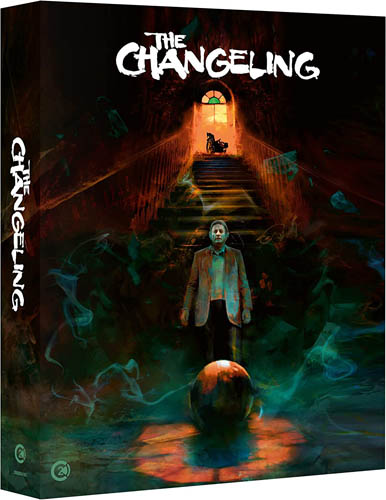
THE CHANGELING (1980)
USA/Canada
AVAILABLE ON 4K UHD and BLU-RAY from Second Sight Films
RUNNING TIME: 115 min
REVIEWED BY: Dr Lenera
John Russell, a composer living in New York, moves across the country to Washington state following the deaths of his wife and daughter in a car accident. In Seattle, he rents a large, old and eerie Victorian-era mansion and begins piecing his life back together by returning to lecture at a college he once worked at many years ago and composing. However, he starts to hear loud thumping noises at 6pm in the morning, while doors close on their own, and windows shatter. He also discovers a blocked off flight of stairs leading up to an attic where he finds a music box dated 1910 which, in a very strange coincidence, plays the same piece of music that he’s composing. He decides to hold a séance, where the spirit manifests itself and gives him a series of clues regarding its murder….
Much like The Legend Of Hell House, The Changeling is another ghost movie from the 1970’s which has a reputation of both being very good and being very scary. Now I know that this may surprise many of you, but I’ve never been that taken with The Legend Of Hell House. I’ve seen it several times, and have always found it to be a bit disappointing, though it improved somewhat on a second viewing and certainly wasn’t a bad movie except for its really rather stupid ending, though I was still never really frightened. I hadn’t seen The Changeling at all until comparatively recently and was setting myself up for a letdown. The letdown didn’t really happen, though they may partly have been due to me having not that high expectations. That might sound weird, but for me personally, many of the films that are often mentioned as being really frightening end up not really doing it much for me, while more unsung titles tend to take me by surprise. However, The Changeling actually managed to be properly creepy and scary for its first half, and worked me up nicely, but then….well, the film certainly didn’t “lose it”, as it had a good, compelling story well told, but it kind of lost the edge that the first half contained. As I mentioned in my review of What Lies Beneath [though The Changeling’s second half is still far superior to What Lies Beneath’s which is just so messy], this is something that seems to be quite common to this sort of movie, as being scared gives way to investigating why the characters, and us, are being scared. Surprisingly stylish and even “full-on” in places for a film that seems to generally be considered a very subtle piece, The Changeling may not quite be the spooky masterpiece some claim it to be, but it’s still a must see for fans of the genre.
Its origins lie in a newspaper article found by Diana Maddox, the then-wife of co-producer Joel B. Michaels, which was written by writer Russell Hunter. He described a ghostly encounter he had when he was living in a place called the Henry Treat Rogers Mansion in Denver, Colorado, in the 1960’s. Star George C. Scott was interested in a proposed film adaptation produced by Joel B. Michaels, Garth H. Drabinsky and Mario Kassar from the beginning. It originally had Tony Richardson attached as director, but he left to do something else, then Donald Cammell, who left because of that old chestnut ”creative differences”. Peter Medak, who’d only made one film prior to this one, was sent the script and after reading it was so scared that he wouldn’t go downstairs in his house. However, Medak only agreed to do it if they scrapped the idea of shooting it in the house that Cammell had chosen, a place which Medak thought didn’t look haunted, and instead built a Victorian façade on an existing house for the exteriors and elaborate interconnecting sets for the interiors. After much deliberation, the producers agreed. The film was shot in Vancouver with some establishing shots in New York and Seattle. During the shooting of the ball scene, it wouldn’t land in the right place despite trying various methods. Medak decided to give it a go and it hit the spot first time round. 79-year old Melvyn Douglas was making Being There concurrently and constantly had to fly back and forth between Vancouver and various California locations. After viewing rushes, the producers decided that editor Barry Wince by replaced by Lila Pedersen, because they wanted a faster tempo to the picture. It was a moderate box office and critical success.
The opening titles, set against black with only the sound of a quiet wind to accompany them, lead in to a scene which is almost as traumatic as the beginning to Don’t Look Now. It’s snowy winter, and John and his wife Cathy are pushing their broken down car out of the road. Then Cathy and their daughter Joanna start playing in the snow while John sees a [very conveniently placed] phone box and goes inside it to ring for help. There, he sees a truck trying to avoid a car coming the other way and then crashing into his car, wife and daughter before his very eyes. What makes the moment so effective is that John seems to sense something is wrong a few seconds before the incident actually happens, but it’s as if he’s trapped in the phone box and can’t get out. Though it’s never stated, I wonder if John’s subsequent grief is made worse by feelings of guilt, that he could maybe have saved them? Anyway, John moves away to a hotel, gets back his old job, and thinks that he’s found the perfect house to hole up and do some composing. The house, like the one in Burnt Offerings, is Victorian with all the creepiness that usually goes with that, but unlike the one in that film, this house is far more sparse. Medak and cinematographer John Coquillon use the setting to greater effect though, with a brilliant early tracking sequence where the camera takes in a woman cleaning the dining room table, then moves on to pass a man putting some books on shelves, then slowly tracks down a corridor to finally reveal John playing the piano.
What with bumps in the night [or rather early morning] and other stuff leading to a glimpse of a dead boy in the bath, plus somebody telling him: “This house is not fit to live in. It doesn’t want people”, it’s a wonder why John remains there, but then it seems that he could be almost numb to it all after what he’s suffered. After finding a hidden attic with a music box, and discovering that the previous owners had both their daughters die in similar accidents, John opts to hold a séance, and it’s a rather convincing one, what with the actress playing the medium almost underplaying being possessed, though the most spine chilling bit of the film is just after, when John plays back the recording of the séance and this time hears the voice of the boy ghost. As the camera goes up the stairs to show the boy being drowned by his father in the bath in a rather upsetting murder scene, we hear the poor boy’s voice crying: “Father, don’t”, and it’s just so sad and eerie at the same time. The boy then reveals his name – Joseph Carmichael – the surname being the same as a local senator. He then gives out a set of clues which Joseph, aided by estate agent Claire, decide to follow up. The story is fascinating so we’re definitely not bored, and takes in a section with a body in a well which I’m damn sure influenced Ringu. However, the tension is lessened by relying more on talk and non-supernatural matters, and it all climaxes in a very cliched fashion. It’s possible to feel somewhat cheated because we don’t get a big climactic scare, but on the other hand it’s also possible to enjoy the way the film concentrates on following a story to its natural conclusion without adding gratuitous thrills, and over time I’ve come to appreciate more the way that it does this.
The Changeling is famous in horror circles for its wheelchair which moves by itself, and I wondered if an early scene where it just travels a few inches was the scene in question until we got an actual chase later, a bit which didn’t terrify me in the way it probably should have done, though I could say the almost same about the Psycho shower murder. Psycho was a film I saw quite late in the day, though already being a film lover I’d read a great deal about it. Unfortunately I may have read too much about it, and had also seen several imitations and even spoofs of it, so that when I watched the actual scene, it didn’t really have that strong an effect, though I was of course still able to admire its technical brilliance. More unsettling for me in The Changeling was Joanna’s ball bouncing down the stairs to John; good chilling stuff yet very simple. And what works really well throughout is the way the camera constantly moves, often in circular patterns, around the rooms of the house, the wide angle lenses chosen making the environment look a bit distorted and “off”. Sometimes we even seem to adopt Joseph’s point of view, while we never actually see him except in the flashback and as a vision of a dead body. It’s all very well handled by Medak [probably best known for the first and best film about The Krays] who never directed another film like it in his rather spotty career, and who wound up doing mostly undistinguished TV work.
Scott, paired with his wife Trish Van Devere for the sixth time, rather underplays his role and almost seems too low key, but then he is playing something of a shell of a man so it kind of makes sense. His approach reminds me of Cliff Robertson’s in Obsession. It’s Douglas [who in the twilight of his career would play a not too dissimilar role the following year in Ghost Story which also has its frightening moments] who gives the standout performance to me eyes and ears, as a person with great power and authority where one can visibly see an underlying fear starting to creep through. The score by the little-used Rick Wilkins plays a major part throughout. Sometimes the film seems to rely a bit too much on the music, which is present very often, but it’s such splendidly effective stuff, Wilkins using everything from scratching string patterns to wordless vocals to unnerve the viewer, though the lullaby-type piece that John writes and is heard in the music box [something not really explained though it’s nice to have some mystery left isn’t it?] l was actually written by Howard Blake. It’s the best horror score this film music fan has heard in ages and he’s now going to go and order a copy. Despite dipping a bit in its second half, and in the end – except for that moment just after the séance I described earlier – not really having the feeling of sadness I think most of the great ghost stories possess in varying degrees, The Changeling oozes class and is still essential viewing for the horror lover. It should still frighten – maybe not loads but certainly a bit – late at night with the lights out. And it’ll certainly stay with you for some time, while the effect of all those jump scares in the latest Blumhouse offering has long vanished.
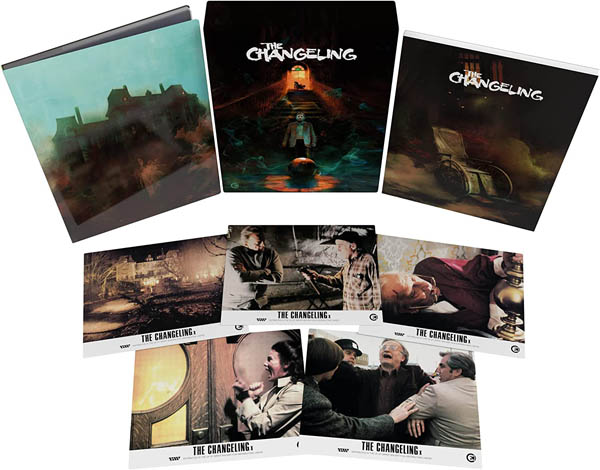
Second Sight Films release of THE CHANGELING
Second Sight Films have released a bumper limited edition release of THE CHANGELING with a rigid slipcase featuring artwork by Christopher Shy, a 108 page book with new essays by Martyn Conterio, Alexandra Heller-Nicholas, Rich Johnson, Mikel J Koven, Meagan Navarro, Rachel Reeves, Shelagh Rowan-Legg, and Heather Wixson, as well as an archive interview with director Peter Medak, the original soundtrack CD and five collector’s artcards.
The disc itself, whether you buy the limited edition or standard edition 4K UHD or Blu-Ray, comes with a wonderful selection of special features that give background to the movie, including:
Audio Commentary with director Peter Medak and producer Joel B. Michaels
Recorded on 18th October 2017 and hosted by David Gregory from Severin Films, this audio commentary with The Changeling’s director Peter Medak and producer Joel B. Michaels provides so much juicy insight into the making of the film which film fans will lap up. They talk about the set design, which cost half a million dollars, and how the original cottage was unsuitable which meant they had to get the extra money required to build a facade as the exterior and use a set as the interior. The both of them talk about how they’d heard stories that George C. Scott was difficult to work with but found nothing of the sort from their experience with him on The Changeling and praised his performance.
A fascinating audio commentary that provides great detail about the making of The Changeling.
Interview with Peter Medak by filmmaker Adrian Garcia Bogliano at Morbido Fest 2018 (1 hour and 14 minutes)
A fantastic and extensive interview with Peter Medak, with a fantastic host in Adrian Garcia Bogliano who asks Peter about his life and how it influenced his directing. Medak talks about growing up in Hungary and the struggles there, before discussing his arrival and subsequent career in the UK. He discusses his path to becoming a film director, as an Assistant Director for Universal, before then adapting the book Negatives into a film with Glenda Jackson for Paramount, his directorial debut.
During the interview, Medak also talks about how he enjoyed working in such a rich era of the 50’s and 60’s, his filmmaking relationships and processes, and his involvement with Pink Floyd’s Dark Side of the Moon gig videos.
Exile on Curzon Street – Peter Medak on this early years in swinging London (19 mins 46 secs)
Peter Medak discusses his arrival in London and his aunt Lotte who was very influential in his life. He talks about how, over the span of three years after arriving in London, he worked through every department in film and got to grips with how the different aspects worked. He talks fondly of striking up his first real friendship in 1959 with Nicholas Roeg who was working as a camera operator at the time, and the two were friends ever since. He also chats about working on Hammer Horrors with the stars like Peter Cushing and Yvonne Romain. A great interview that gives insight into how it was getting into the industry at such a time.
The House of Cheesman Park – The Haunting True Story of The Changeling (17 mins 30 secs)
Historian and author Dr Phil Goodstein delivers a shocking account of the Henry Treat Rogers mansion on Cheesman Park that became the inspiration for The Changeling. e explains how there was a cemetery in Mount Prospect, Denver, that held up to 20,000 bodies, that the city wanted to convert into a park. After giving the contract to the lowest bidder, the company hired cut corners with cheap labour, including using coffins that were too small and putting body parts in different coffins. Following this, the city instructed the families of the deceased to move the bodies or else they’d be forever buried under the planned park. Not all bodies were relocated, and thus a mansion that was built on the land, occupied by Henry Treat Rogers who was heavily involved in the development from cemetery to park, began to experience strange goings in. The haunting especially came to light years later when a composer by the name of Russell Hunter moved into the property, and much of what is in the film reflects the experience of Hunter.
The details in this segment are fascinating. Like with any ghostly account, how much of it is true and how much of it isn’t can be left to interpretation, but it’s interesting nevertheless to listen to the enthusiastic Dr Goodstein give us juicy details about the ‘true story’ that led to the movie The Changeling.
The Music of The Changeling – An Interview with Music Arrange Kenneth Wannberg (8 mins 58 secs)
Having worked with directors, such as Steven Spielberg, Walter Hill, George Lucas and Martin Scorsese, on movies including Stars Wars Episodes 1-6, Jurassic Park, Harry Potter and the Sorcerer’s Stone, Home Alone, JFK, and Raiders of the Lost Ark, Ken Wannberg discusses his collaborations with John Williams. He talks about how they first worked together on Valley of the Dolls, and his process of creating and planning the music for The Changeling before delivering it to the orchestra to perform.
Building The House of Horror – Interview with Art Director, Reuben Freed (10 mins 53 secs)
Rueben Freed discusses how he wanted to be a documentary filmmaker, but then changed his mind once he started working in the film industry in Canada as a set designer under the tutelage of Trevor Williams, which is how he ended up working on The Changeling. Freed fondly discusses Trevor Williams’ attention to detail and talks about how they would approach the exterior and interiors for the movie.
The Psychotronic Tourist (16 mins 6 secs)
Kier-La Janisse, author of House of Psychotic Women, presents The Psychotronic Tourist, where they revist locations used in movies. With the help of others, including Michal Gingold of Fangoria, director Ted Geoghegan and FX artist Ryan Nicholson, we get to ‘visit’ some of the locations used in The Changeling, such as the Lincoln Center, the location of the original house on 57th Avenue in Vancouver (it’s no longer there), and the Orpheum Theater.
I really enjoy watching these location visits, as they show you how the location looks now and what it looked like in the film with film footage interlaced with modern day. Not all of us can fly across the ocean or go on a road trip to see, so this gives you an idea from the comfort of your own sofa.
Master of Horror Mick Garris on The Changeling (5 mins 30 secs)
In this featurette interview, Mick Garris talks about his love of the film, its emotion, the performances (especially from George C. Scott) and the classic style of horror which Peter Medak had gone for. Mick also discusses how Peter Medak was perfect to be involved with the Masters of Horror series he headed, where Medak directed The Washingtonians episode.

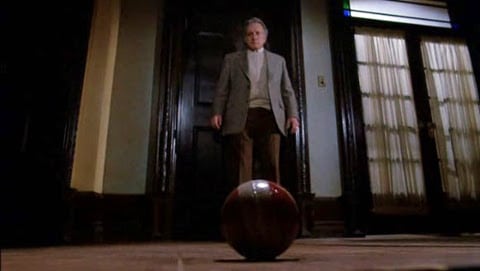
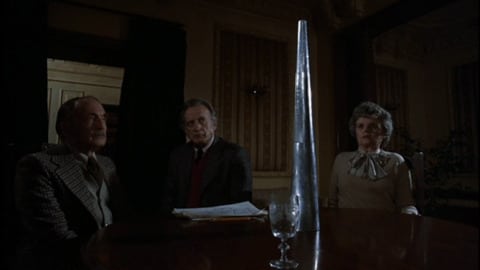




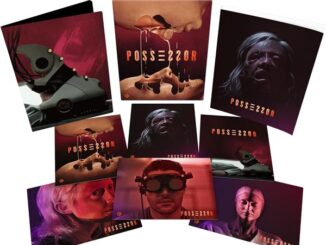
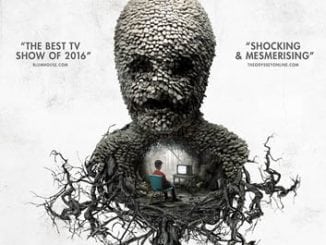
Be the first to comment